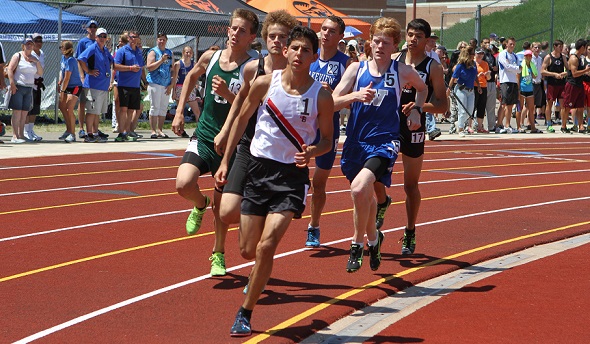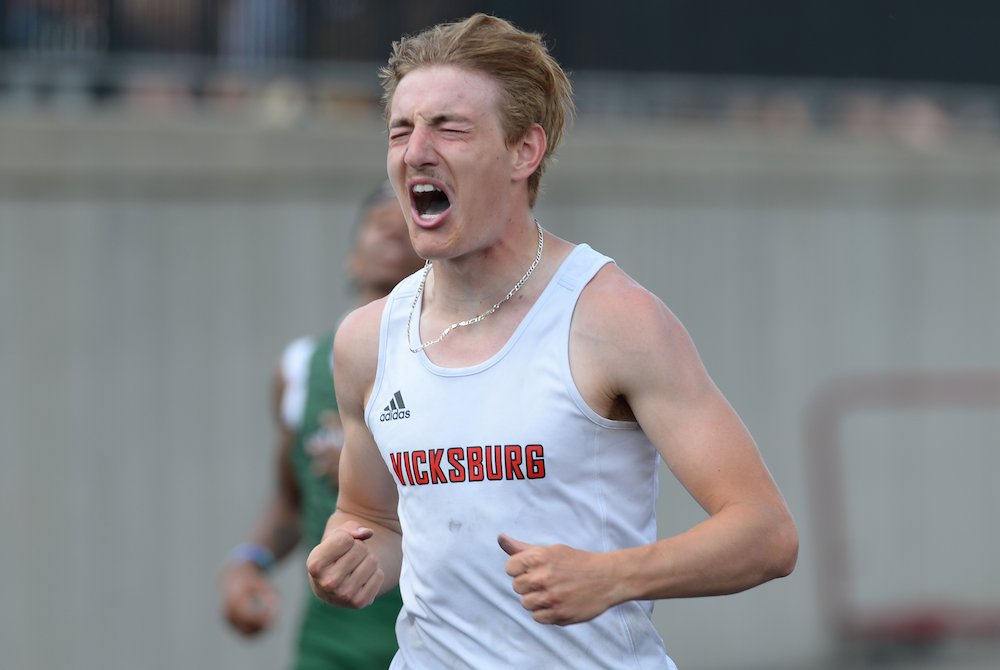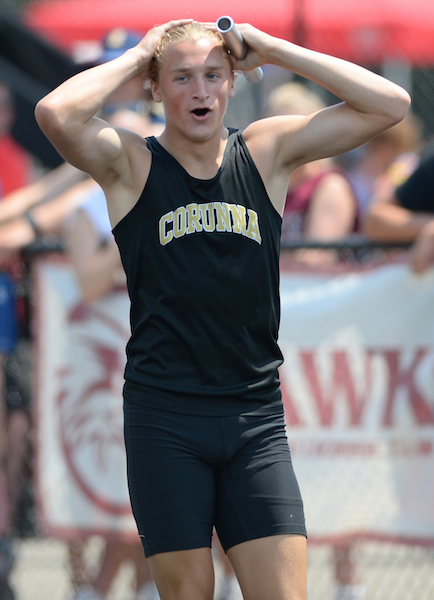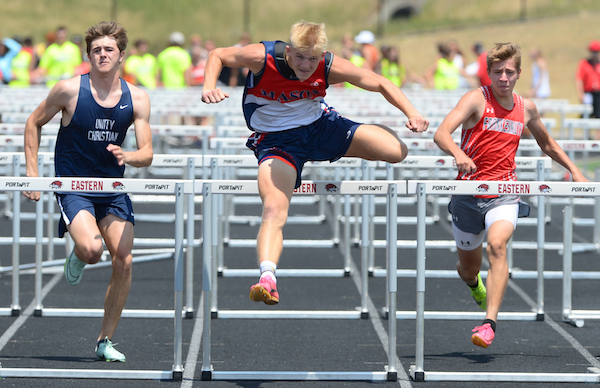
Fisher Goes the Distance at LP D1 Final
May 31, 2014
By Bill Khan
Special to Second Half
ROCKFORD — Grant Fisher wasn't going to get snuck up on again.
As a sophomore last year, Fisher came down the final stretch with the lead in the 1,600-meter run at the MHSAA Lower Peninsula Division 1 Track and Field Final, only to be caught from behind by Lake Orion's T.J. Carey and lose by sixth-thousandths of a second.
The Grand Blanc distance star made up for it later in the day by winning the 3,200, then went on to win the MHSAA Division 1 and Foot Locker national cross country championships in the fall.
The one title he still lacked was the MHSAA 1,600 crown, which he took care of Saturday by jumping out to the lead and never looking back.
Fisher won in 4:10.82, having built a sizable cushion over fast-finishing Traverse City Central sophomore Anthony Berry, who took second in 4:12.64.
"Last year in the last 100 meters I got caught by T.J.," Fisher said. "That was a really disappointing one, because I was so close. This year, I wanted to get a victory this time and I didn't want to leave it too close to call. Usually, I sit and kick, but today it's about winning. I'll do what it takes to win."
With a 1,600 victory under his belt, Fisher took a different approach a couple hours later in the 3,200. He sat behind Royal Oak's Ben Hill until 200 meters remained, then won a sprint to the finish with a time of 9:07.11, covering the final lap in 59 seconds. Hill took second in 9:09.34.
Fisher became only the second boy in the last 12 years to sweep the distance events in LP Division 1, the last being Monroe's Justin Heck in 2008. Of seven runners who have swept the 1,600 and 3,200 in LP Class A or Division 1, only future Olympian Dathan Ritzenhein of Rockford had a faster combined time. Ritzenhein posted times of 4:08.08 and 9:00.63 in 2000.
"My plan going into the race was with 150 (meters) to go to make a move," Fisher said. "That's what I did. I had to wait like that, because I was pretty tired from the mile. That was a huge goal of mine to win the mile and two mile."
Fisher wasn't the only boy to turn in elite-level performances.
Junior Donavan Brazier of Grand Rapids Kenowa Hills set an MHSAA all-Finals record in the 800 with a time of 1:50.24. He broke the mark of 1:50.63 set by Rick Gledhill of Mt. Clemens Chippewa Valley in the 1988 LP Class A meet. Brazier was pushed down the stretch by Waterford Mott's Brennan Munley (second in 1:51.79) and Milford's Brian Kettle (third in 1:52.39).
"A 1:50 was pretty surprising," Brazier said. "I was hoping for a (personal record) from 1:52. I just hung on until the last 200 and gave it all I've got."
Saline's 3,200 relay team of John Davis, Ryan Gauche, Ryan Wilkie and Logan Wetzel set an all-Finals record with a time of 7:40.54, breaking Saline's mark of 7:41.27 set in 2004. Victory wasn’t even a given until Wetzel overtook Okemos on the final lap after the Hornets were in third place for much of the race. Wetzel ran a 1:50 closing leg.
"It's really hard to press in that last 200, 300 meters when you're all alone," Wetzel said. "Definitely having a guy to battle with made all the difference."
Oak Park senior Maurice Allen had the stamina to complete a difficult double, winning the 400 in 48.13 seconds and coming back three events later to take the 200 in 21.36. Earlier, he ran on a second-place 800 relay team.
"You're tired, but the thing is to get out in the lead in the first part of the race," Allen said. "If you can start, you can finish."
The only other athlete to win two individual events was Swartz Creek senior thrower Kevin Weiler. Weiler won the discus at 176 feet, 5 inches and the shot put at 60 feet, 4.5 inches.
East Kentwood won its fifth team championship in six years, scoring 71 points to beat Oak Park by 21. Saline was third with 37 points.
"It's one of those things where we're not necessarily winning everything, but we're taking seconds and thirds and scoring twice in events," East Kentwood coach Dave Emeott said. "It's a very special group of kids who worked crazy hard."
Antoine Lloyd, Kevin Smith and Devin McKinney each scored in four events for the Falcons. Lloyd had a hand in 27 points, winning the 110 high hurdles, taking second in the 300 hurdles, taking fourth in the high jump and running on a fifth-place 1,600 relay team. McKinney scored 25 points, taking third in the 110 hurdles; running on the winning 800 relay team with Smith, Ashley Bailey and Michael Catching; running on a sixth-place 400 relay team; and taking third in the 200. Smith had a hand in 23 points. He was on the winning 800 relay team.
PHOTO: Grand Blanc’s Grant Fisher leads a pack around a turn during the 1,600 at the Lower Peninsula Division 1 Final on Saturday at Rockford High School. (Click to see more from RunMichigan.com.)

Vicksburg's Wright, Corunna Right On in Claiming LPD2 Championships
By
Steve Vedder
Special for MHSAA.com
June 3, 2023
ADA – If Michael Wright was a baseball player, he probably would've been called out on strikes a year ago.
Instead, the Vicksburg senior can celebrate after winning the 200 at Saturday's Lower Peninsula Division 2 Track & Field Finals at Forest Hills Eastern.
The road to the championship in the 200, via a time of 21.72, was anything but a straight line for Wright. An aspiring baseball player, he was cut from the Vicksburg squad as a freshman. His football career, by Wright's own admission, was "on and off." And then a year ago in his first track meet, Wright suffered a leg injury that virtually ended his season. He did return to finish fifth in the 200 at Finals while helping the 400 relay team to a 16th place.
So there is nothing to realistically explain how Wright found himself in the position Saturday at sweltering Forest Hills Eastern to win a championship. Except for returning this season to break the school record in the 200 four times in two months. Well, that and willpower and simple desire.
 "I knew I could finish high, maybe in the top five. But this is better," said Wright, who credits drinking large quantities of milk for his resurgence. "I looked to football because I didn't think I could bounce back for track. But I overcame the bumps, the obstacles."
"I knew I could finish high, maybe in the top five. But this is better," said Wright, who credits drinking large quantities of milk for his resurgence. "I looked to football because I didn't think I could bounce back for track. But I overcame the bumps, the obstacles."
While Wright was jump-starting his track career, Corunna won the team title with 41 points. Mason and Forest Hills Eastern tied for second with 35. Whitehall was fourth with 33 points, and Frankenmuth fifth with 29 points.
Corunna coach Jeff Sawyer, who had never won a Finals title in 37 years coaching at Owosso and three more at Corunna, said the championship came after little fanfare during the season. Virtually right up until the time Corunna hauled off its first-place trophy, Sawyer said it was never really on his team's mind. The title came after the team managed only a runner-up finish at the Regional.
"We kind of low-keyed it," he said. "We knew scoring 40 points was possible. We lost to Frankenmuth by one point at the Regional. … We were a little disappointed we didn't win, but we had some good times today. We knew it was possible.
"Every day we just come and do what we do. We talk about getting better every day with PRs (personal records). And we're still getting better because we have some tough guys. Just competitive, tough kids. But we were the underdogs."
Corunna had only two firsts on Saturday, in the 400 relay (42.63) and Wyatt Bower in the long jump (22-8½).
Among the individual highlights was Frankenmuth senior Dalton DeBeau, who successfully defended his Finals title in the discus (171-6). He was fifth in that event as a sophomore and after winning a year ago, was considered a good bet to repeat.
"I kind of expected it," said DeBeau, who will compete at Michigan State next spring. "There wasn't a lot of pressure. I knew what had to be done. I threw 160 feet on my first throw to get in the finals, and that helped right away. I knew I could go all out."
 Berrien Springs' Jake Machiniak won the 100 (10.54) while the team also captured the 800 relay (1:28.18). Machiniak said his season hasn't been without its share of difficulties. There was a time when he couldn't seem to come out of the starting blocks smoothly. But beginning with the conference meet where he ran school record 10:73, Machiniak felt himself back on course.
Berrien Springs' Jake Machiniak won the 100 (10.54) while the team also captured the 800 relay (1:28.18). Machiniak said his season hasn't been without its share of difficulties. There was a time when he couldn't seem to come out of the starting blocks smoothly. But beginning with the conference meet where he ran school record 10:73, Machiniak felt himself back on course.
"There were ups and downs. I struggled in the middle of the season," he said. "But my teammates helped me through some difficulties. I came here to finish the job; I knew I could do something here."
Mason's Tyler Baker won the 100 hurdles (14.63) to complete a long journey that included finishing just ninth in last year's prelims. The success was as simple as putting in loads of offseason work.
"I practiced and did stuff about every day," he said. "I might not be the fastest, but I make up for that in form. It's a fine-tuning thing. Everyone wants to be faster."
Mason also got a championship from A.J. Mantel, who captured the 300 hurdles (38.90).
Among other highlights was Forest Hills Eastern senior Aiden Sullivan successfully defending a 2022 title on his own home turf. He won Saturday's 800 (1:53.92).
Adrian won the 3,200 relay (7:39.77), while Grand Rapids Christian took the 1,600 (3:24.49).
Alma had two individual winners in Michael Howey in the shot (55-08) and Jacob Dunlap in the high jump (6-7).
The other champs were Kyle Eberhard of Linden in the 1,600 (4:14.79), Whitehall's Trannon Ayler in the 400 (48.83), Freeland's T.J. Hansen in the 3,200 (9:11.56) and Sam Vesperman of Grosse Ile in the pole vault (15.01). Chelsea senior Jacob Nelson competed in the adaptive 100 (27.28), 200 (57.71) and shot put (6-6).
PHOTOS (Top) Vicksburg's Michael Wright celebrates after winning the 200 on Saturday. (Middle) Corunna's Tarick Bower enjoys a moment after anchoring the winning 400 relay. (Below) Mason's Tyler Baker, center, works to stay ahead in the 110 hurdles. (Photos by Dave McCauley/RunMichigan.com.)

